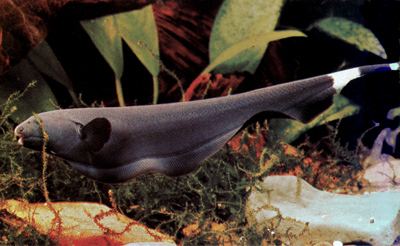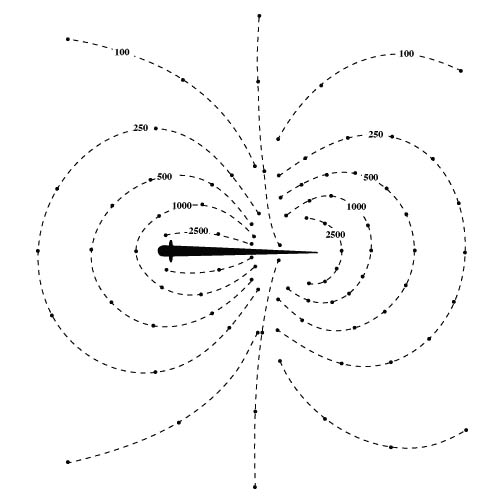 The Nelson Lab's research is focused on active sensory acquisition. We seek to understand neural mechanisms and computational principles that animals use to actively acquire sensory information in complex, dynamic environments. We are interested in systems-level integration and interactions of:
The Nelson Lab's research is focused on active sensory acquisition. We seek to understand neural mechanisms and computational principles that animals use to actively acquire sensory information in complex, dynamic environments. We are interested in systems-level integration and interactions of:
- neural coding and spike train statistics
- sensory signal detection and estimation
- active repositioning of sensor arrays
- multiresolution adaptive filtering
- processing of clustered sensory signals
- generation and subtraction of sensory expectation
We study these processes in the electrosensory system of weakly electric fish, using a combination of behavioral, electrophysiological, and computational neuroscience approaches.
Our Principal Investigator is Mark E. Nelson.
Click the tabs below learn more about our research or check out our website here to learn more.
Studies of neural information processing in general, and sensory acquisition in particular, are best carried out under conditions that closely approximate the animal's natural environment. Each species has evolved solutions that are adapted to its own behavioral needs and ecological niche. Within this context, we can ask meaningful questions about how the nervous system acquires and processes sensory information. The neural mechanisms and information processing principles that emerge from a careful neuroethological study can have implications beyond the particular system in which they are elucidated. While focusing on the neural and behavioral strategies used by weakly electric fish to detect and capture prey, our goal is to contribute toward a broader understanding of general principles of sensory acquisition. Specific areas of interest include optimal positioning of receptor structures, efficient neural coding, task-specific adaptive filtering, and the generation and subtraction of sensory expectation. Many of the details will, of course, be specific to the electrosensory system, but the general principles that emerge should be broadly applicable to many other systems. Ultimately, we hope to come away with a deeper appreciation of how animals achieve their remarkable information processing capabilities.
 To help guide behavior in complex, dynamically changing environments, animals must extract useful information from a barrage of physical stimuli impinging on their body surface. To meet this challenge, animals have evolved sophisticated sensory systems for encoding and optimizing the behaviorally relevant content of incoming signals. The focus of our research is on how the nervous system controls the acquisition of sensory information from the environment. How do animals cope with the real-time processing of sensory data from large numbers of input channels? How is the information encoded? How does the nervous system extract interesting information from the data stream while ignoring irrelevant background noise?
To help guide behavior in complex, dynamically changing environments, animals must extract useful information from a barrage of physical stimuli impinging on their body surface. To meet this challenge, animals have evolved sophisticated sensory systems for encoding and optimizing the behaviorally relevant content of incoming signals. The focus of our research is on how the nervous system controls the acquisition of sensory information from the environment. How do animals cope with the real-time processing of sensory data from large numbers of input channels? How is the information encoded? How does the nervous system extract interesting information from the data stream while ignoring irrelevant background noise? Weakly electric fish can influence the information they acquire through repositioning of their peripheral electroreceptor array, which covers the body surface. We have explored the role of body positioning in electrosensory acquisition by carefully analyzing the prey capture behavior of the black ghost knife fish, Apteronotus albifrons (Nelson and MacIver 1999
Weakly electric fish can influence the information they acquire through repositioning of their peripheral electroreceptor array, which covers the body surface. We have explored the role of body positioning in electrosensory acquisition by carefully analyzing the prey capture behavior of the black ghost knife fish, Apteronotus albifrons (Nelson and MacIver 1999  Prey-related signals are weak, typically on the order of a few mV or less at the time of detection. These small voltage signals are transformed into correspondingly small change in the firing rate of P-type afferents. During a prey capture event, the typical baseline afferent firing rate of 300 spikes/s might increase by just a few spike/s. From the perspective of a single afferent fiber, this increase is transient, lasting only a fraction of a second as the prey image sweeps over the receptor array. How does the nervous system cope with the problem of detecting such weak, transient changes in sensory input? We discovered that a key strategy used by the electrosensory system is to reduce the intrinsic noise of primary afferent spike trains (Ratnam & Nelson 2000
Prey-related signals are weak, typically on the order of a few mV or less at the time of detection. These small voltage signals are transformed into correspondingly small change in the firing rate of P-type afferents. During a prey capture event, the typical baseline afferent firing rate of 300 spikes/s might increase by just a few spike/s. From the perspective of a single afferent fiber, this increase is transient, lasting only a fraction of a second as the prey image sweeps over the receptor array. How does the nervous system cope with the problem of detecting such weak, transient changes in sensory input? We discovered that a key strategy used by the electrosensory system is to reduce the intrinsic noise of primary afferent spike trains (Ratnam & Nelson 2000